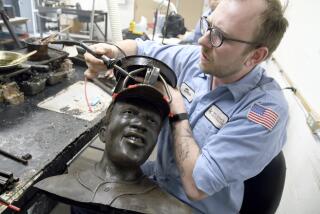Cuba’s Lennon Statue Makes a Spectacle of Itself
- Share via
HAVANA — Who keeps swiping John Lennon’s glasses?
Twice in three months, thieves have ripped the bronze granny glasses off a statue of the former Beatle in a neighborhood park here. That’s a fairly gutsy prank, considering that President Fidel Castro, who is not soft on crime, personally unveiled the statue last December on the 20th anniversary of Lennon’s death.
Now Lennon, once a pariah blasted by Castro’s revolutionaries as a purveyor of the worst kind of imperialist-pig mind rot (they favor a different Lenin here), sits under 24-hour guard, blessed by Castro and fitted with new glasses welded tight to his ears and nose.
“They are not going to get them again, not on my shift,” said Norma Lidia Bandera Blanco, who sits in a rickety beach chair eight hours a day, part of a squad that never leaves Lennon’s side.
Bandera is angry, her socialist sensibilities clearly violated: “It’s wrong. The statue is sitting here for everybody to see, so it’s not right for one person to take it for himself.”
Hundreds of people stop by daily to see the lovely bronze of a lanky, long-haired Lennon sitting cross-legged and pensive on a park bench. Inscribed in the marble at his feet, in Spanish, is a line from “Imagine”: “You may say I’m a dreamer, but I’m not the only one.”
“Castro said, ‘I’m a dreamer, too, like Lennon,’ when he unveiled the statue,” said Noel Nicola, 55, who runs a music publishing business. Nicola said that during the height of the Beatles’ popularity in the 1960s, Cuba was fresh from Castro’s 1959 revolution, and everything Western was seen as a threat.
*
But four decades later, Nicola said, Cuba and Castro have mellowed and matured, and an enormous talent like Lennon is now judged in a more nuanced way. At the unveiling, Castro--himself a frequent assassination target--told people he wished he’d met Lennon and regretted he was so busy in the 1960s that he’d had little time to listen to his music.
In truth, most of the people who stop by the statue couldn’t tell Lennon from a yellow submarine. Bandera describes the man she guards as a “famous American singer”; others shrug when asked who Lennon is.
But Yovanis Reeves, 22, who was 2 when Lennon died, said he is familiar with Lennon and thinks Cuba is a perfect place for the statue. “John Lennon’s ideas have a lot to do with ours,” said Reeves. “He was a pacifist, and he fought against a lot of the social problems of his time. He was a revolutionary, and he got in a lot of trouble for it.”
Lennon’s glasses disappeared the first time on Dec. 22, two days after the unveiling. Aghast, the city parks department replaced the glasses, welding the bridge to Lennon’s nose, and stationed guards 12 hours a day. But on Feb. 14, the glasses disappeared again. This time, the replacement glasses were welded to both ears and the nose, and guard duty was expanded to 24 hours.
The statue even receives mail. One recent afternoon, a frustrated-looking mailman walked up to it, envelope in hand. It was from a sculpture museum in Japan, addressed to Jose Villa Soberon, the statue’s creator, at “Park 17th and 6th, Havana, Cuba.” “What do I do with this? Is he here? Does he ever come here?” the mailman sputtered at Bandera. Eventually, Bandera said she knew somebody who knew somebody who could find the sculptor and stuffed the envelope in her backpack. Then she sat back down in her beach chair, a sentry for the Revolution.
More to Read
Sign up for Essential California
The most important California stories and recommendations in your inbox every morning.
You may occasionally receive promotional content from the Los Angeles Times.













